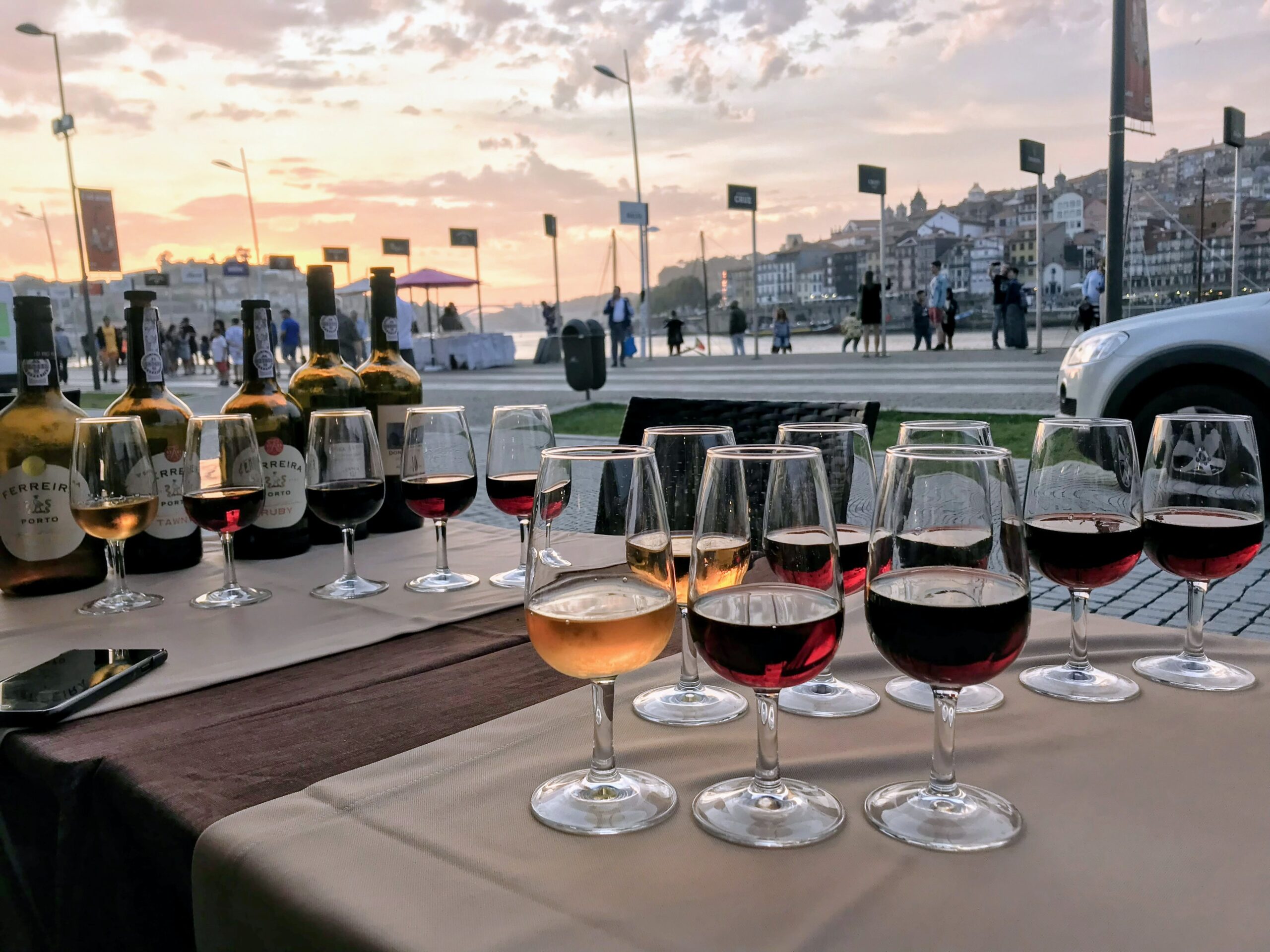Port Tasting in Porto: Which Port Houses to Visit (2025)
Disclaimer: This post may contain affiliate links, which means I may earn a small commission if you make a purchase at no additional cost to you. I only recommend products and services that I would use myself and all opinions expressed here are my own. You can read my full privacy policy here.
I visited three port cellars during my five weeks in Porto and learned that more is not better when it comes to port tasting. Port wine is sweet, strong, and after your second tasting, everything starts to taste similar. Here is what actually matters when choosing which port houses to visit.
About This Guide
I visited Porto for 5 weeks in August 2025, taking port tastings at Porto Cruz, Quevedo, and exploring other cellars. This guide includes honest pros and cons, what I wish I had done differently, and practical tips for booking.
Table of Contents
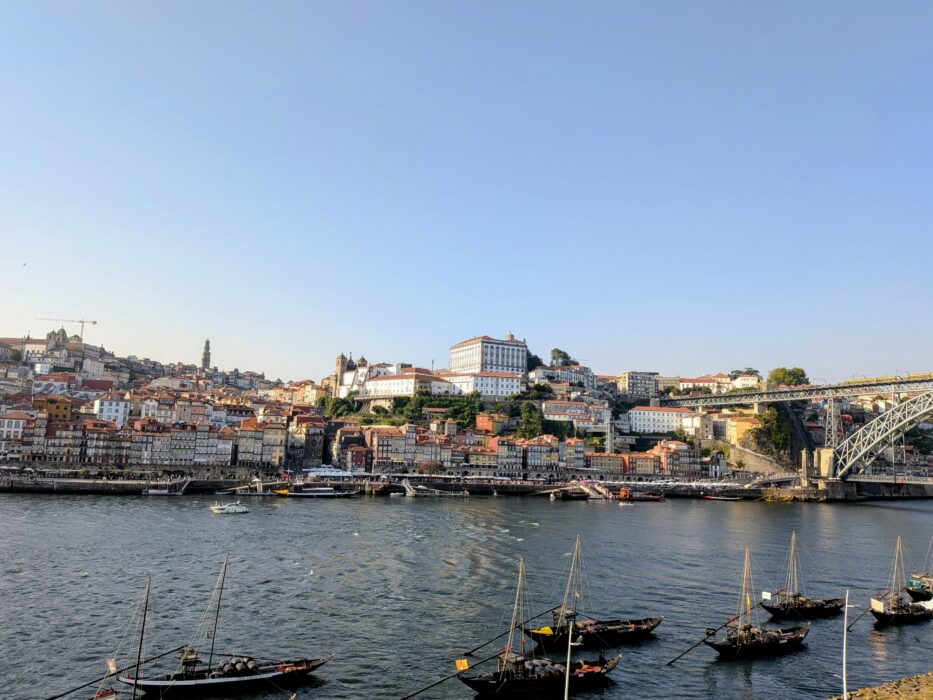
Where Port Cellars Are Located
All the major port houses are in Vila Nova de Gaia, across the Douro River from Porto proper. You need to cross the Dom Luís I Bridge to reach them.
The lower bridge level is easier for most people – flatter, shorter walk, less intimidating. The upper level has incredible views but some people find the height uncomfortable. Both levels get you to the same place.
Once across, the port cellars line the waterfront. You can see the logos and signs from the Porto side – Sandeman, Graham’s, Taylor’s, Porto Cruz, and dozens of others all clustered together.
Walking between cellars takes 5-10 minutes. You could easily visit 3-4 in an afternoon if you wanted. But I do not recommend it.
How Many Port Houses Should You Visit?
My recommendation: Two maximum.
Port wine is 19-22% alcohol. It is sweet. After tasting 4-5 ports at one cellar, you are already feeling it. Visit a second cellar and taste another 4-5 ports, and you have consumed 8-10 different fortified wines in a few hours.
By the third cellar, I could not tell the difference between a tawny and a ruby. Everything was just “sweet wine.” My palate was done.
More importantly, the port house tours are pretty similar. They all show you oak barrels, explain the aging process, tell you about their history. After the second tour, you are not learning anything new – you are just drinking more port.
Better approach: Visit two cellars with very different experiences. One with amazing views (Porto Cruz rooftop), one with an excellent tasting experience (Quevedo’s 4-port discovery). Quality over quantity.
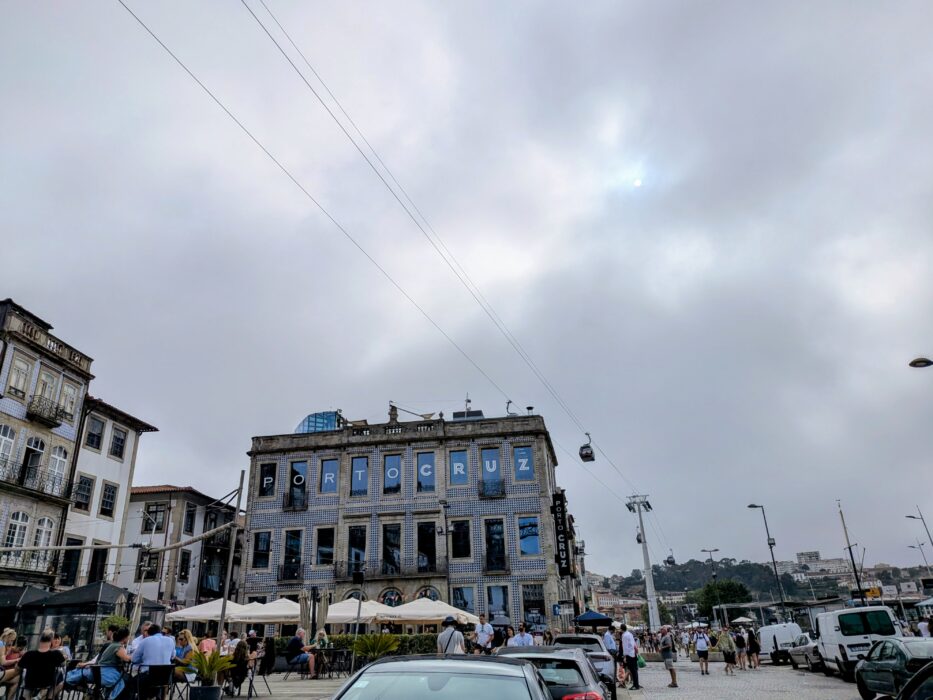
Porto Cruz Rooftop – Best Kept Secret ⭐
This is my favorite porto tasting + rooftop experience and most people do not even know the rooftop part exists.
Porto Cruz is literally next door to Sandeman, one of the most famous port houses in Porto. Everyone goes to Sandeman. But most people don’t seem to know that there is a rooftop terrace serving port (and more) right next door at Porto Cruz. Moreover, Porto Cruz’ rooftop terrace has unobstructed views of Porto and is buzzing but never overcrowded.
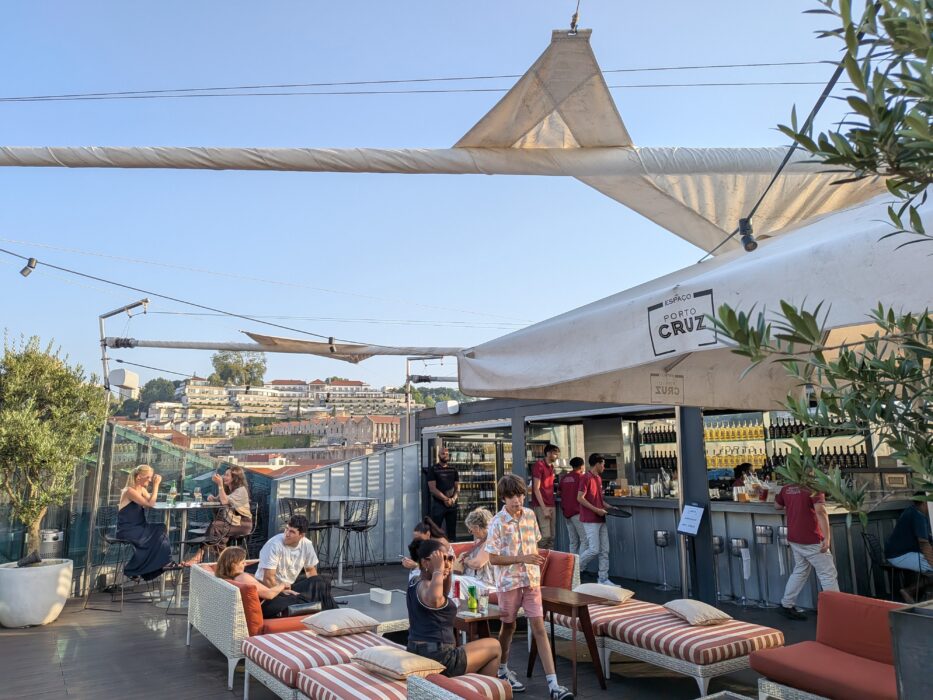
My tip: Walk into the Porto Cruz building. Go to the counter and tell them you want to go to the rooftop. They will direct you to the lifts. That is it. No booking required (though you can book specific tastings in advance if you want).
The rooftop has table service. Order from the menu – they have various port tasting options, cocktails, and light food. We went twice and both times had excellent service with staff making recommendations based on what we said we liked.
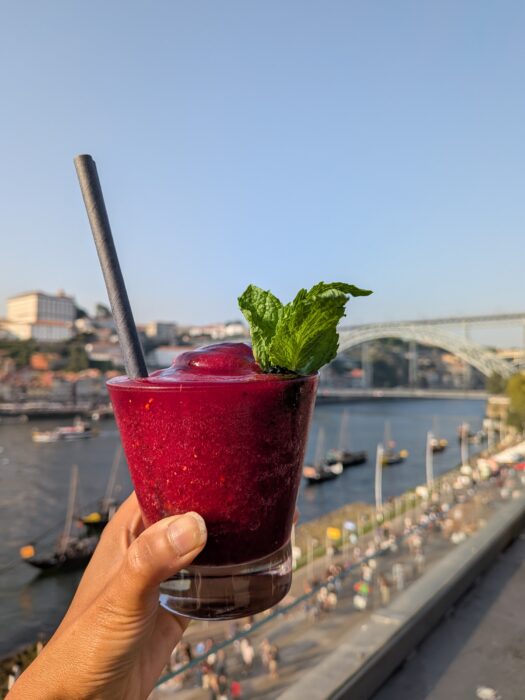
The views: This is the main reason to go. Unobstructed panoramic views of Porto across the river. You can see the Clérigos Tower, the colorful Ribeira buildings, the Dom Luís I Bridge – all from comfortable chairs with a glass of port.
Cost: 15-25 euros per person depending on which tasting you choose.
When to go: Sunset is obviously popular but we went mid-afternoon both times and loved it. Fewer people, better choice of tables, still beautiful views.
Pro Tip
Porto Cruz rooftop is right next to Sandeman but most tourists have no idea it exists. While everyone queues at Sandeman, you can walk straight into Porto Cruz, take the lift to the rooftop, and have incredible views with no wait.
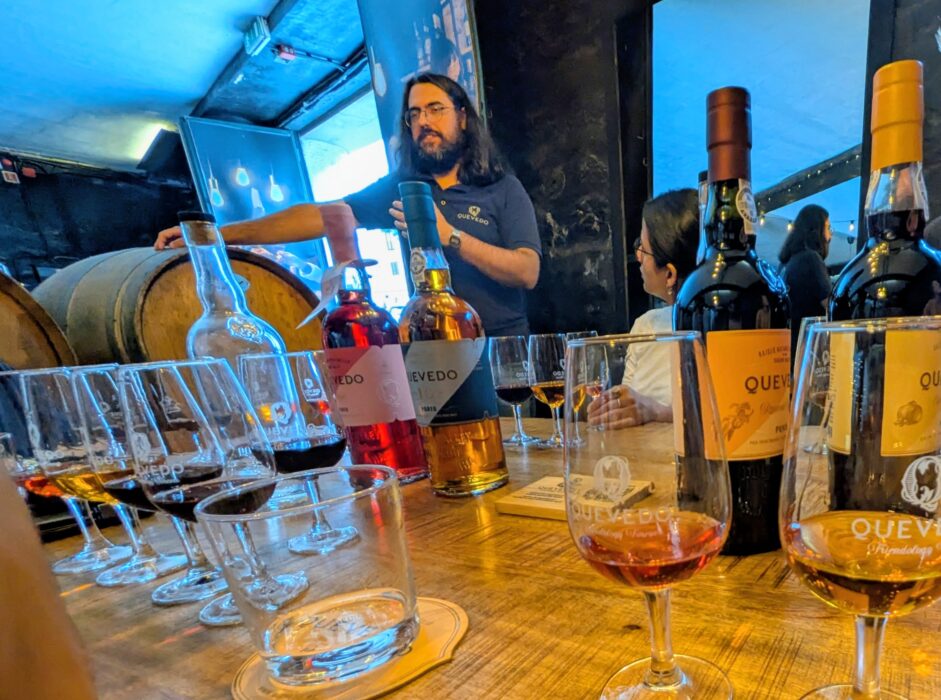
Quevedo Port Discovery Tasting ⭐
We booked the Porto Discovery 4-port tasting at Quevedo. This included a cellar tour and tasting of four different ports: white, tawny, ruby, and vintage.
What I wish I had done: Book the version with cheese. Port is very sweet and drinking four glasses without food is hard. Cheese would have made the experience much better.
The cellar tour: Interesting but similar to other port houses. They show you the aging barrels, explain the production process, tell you about their family history. If this is your first port cellar tour, it is fascinating. If it is your second or third, it starts to feel repetitive.
The tasting: Tables are mixed – you sit with other groups. We chatted with a Dutch couple and exchanged Porto travel stories, which was nice. The guide explained each port as we tasted, gave context on what makes each style different.
Booking: Times are very flexible up until 24 hours before. Book online for better prices than showing up in person.
Cost: 15-20 euros depending on package.
Quick Answer
Visit 2 port houses maximum – Porto Cruz for the secret rooftop with best views (most people do not know about it despite being next to Sandeman), and Quevedo for the 4-port discovery tasting. Book the cheese pairing option if available because port is very sweet and hard to drink without food. Skip visiting more than 2 cellars – after 8-10 port tastings they all blur together. Book online in advance for better prices (15-25 euros per tasting).
Recommended Port Tasting Tours
- Port Wine Tour with 7 Tastings – 45 euros
– 4.8/5 (3,200 reviews) – Visits 3 venues, traditional cellar plus 2 tasting spots, guided walking tour - Cálem Cellar Tour with Interactive Museum – 18 euros
– 4.6/5 (8,400 reviews) – Includes museum, cellar tour, tastings of LBV and Vintage ports - Cálem with Chocolate & Cheese Pairing – 25 euros
– 4.7/5 (1,800 reviews) – Port tastings paired with chocolate and cheese, best value pairing option
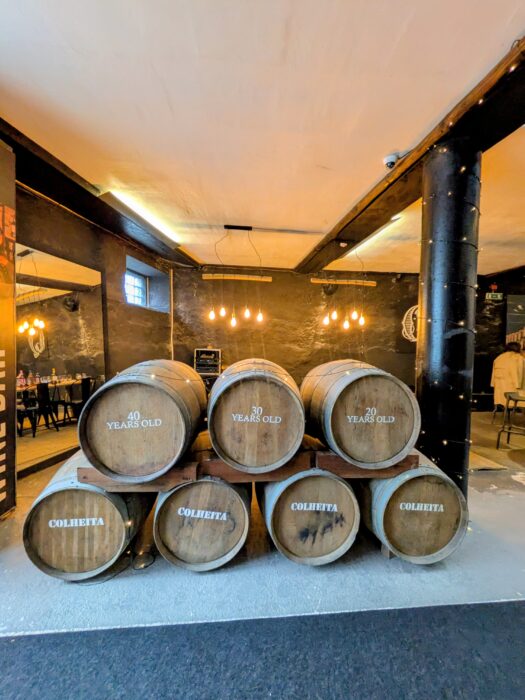
Other Notable Port Houses
Taylor’s Port Cellars
One of the oldest and most prestigious port houses. The recently renovated cellars are beautiful and they offer self-guided audio tours in 13 languages.
What you taste: Chip Dry (extra dry white), Late Bottled Vintage (LBV), and 10-year-old Tawny.
Why go: If you want a self-guided experience instead of a group tour. Good for people who prefer exploring at their own pace.
Cost: Around 15 euros.
Graham’s
Another prestigious house with beautiful views from their lodge. The terrace overlooks Porto.
Why go: Excellent terrace views, well-regarded tastings, premium port options available.
Cost: 15-25 euros depending on tasting level.
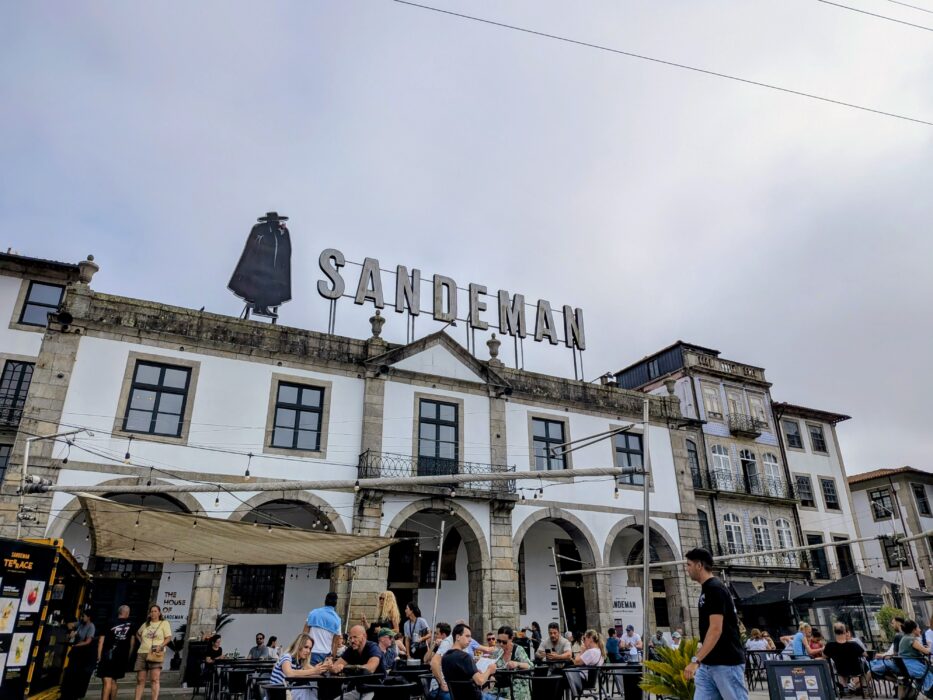
Sandeman
The most famous port house – you will recognize the logo (the man in the black cape and hat). This is where most tourists go first.
Reality check: Sandeman is popular for a reason – good tours, knowledgeable guides, quality port. But it is also the most crowded. Expect lines and larger tour groups.
Cost: 18-30 euros depending on tasting package.
Cálem
Offers various tasting experiences including options with chocolate and cheese pairings. They also have a Fado show combined with cellar tour if you want to see traditional Portuguese music.
Why go: Good pairing options (chocolate and cheese help with the sweet port). Fado combination is unique if you want both experiences in one booking.
Cost: 18-30 euros for tastings, more for Fado combination.
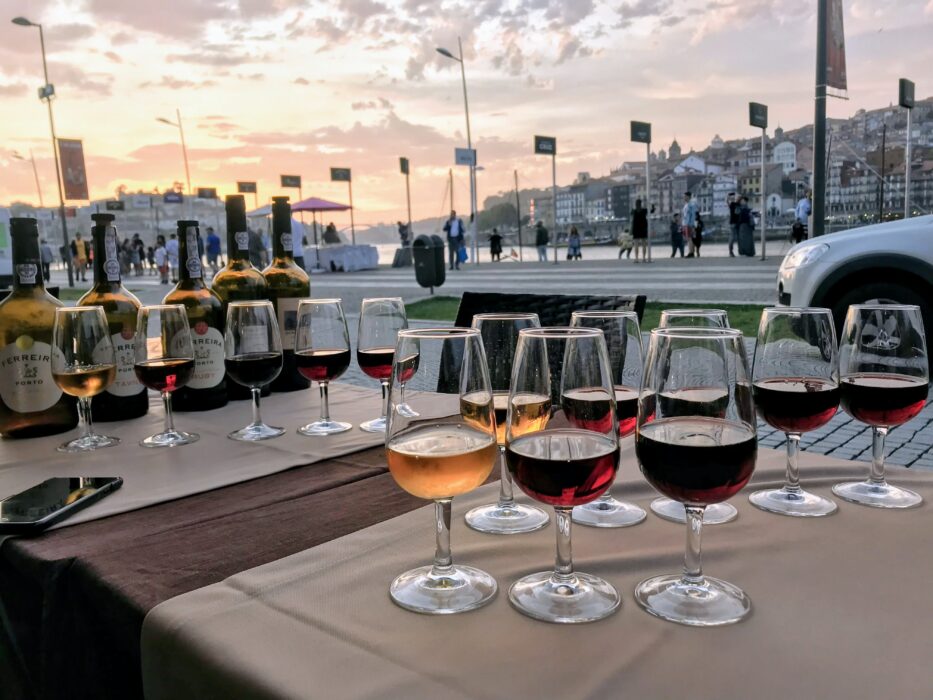
Port Wine 101: What You Are Actually Tasting
Before you visit cellars, it helps to understand what makes port different from regular wine.
Port is fortified wine. During fermentation, grape spirit (brandy) is added, which stops fermentation and leaves residual sugar. This is why port is sweet and has higher alcohol content (19-22%) than regular wine (12-14%).
Main port styles you will taste:
Ruby Port: Youngest style, aged in large oak barrels for 2-3 years. Deep red color, fruity, fresh. Most affordable. Good introduction to port.
Tawny Port: Aged longer in smaller barrels, which allows more oxygen contact. Develops amber-brown color (tawny). Nutty, caramel, dried fruit flavors. Ranges from basic (3-5 years) to aged (10, 20, 30, 40 years). The older, the more expensive and complex.
White Port: Made from white grapes instead of red. Can range from dry to sweet. Often served chilled as an aperitif. Less common than ruby or tawny.
Vintage Port: Made from grapes from a single exceptional year. Only declared in outstanding harvest years (maybe 3 times per decade). Aged in bottle for decades. Most expensive and prestigious. Very sweet, very intense.
LBV (Late Bottled Vintage): Like vintage port but aged longer in barrels before bottling (4-6 years). More approachable than vintage, less expensive, ready to drink when purchased.
According to the Instituto dos Vinhos do Douro e do Porto (IVDP), port wine has been produced in the Douro Valley for over 2,000 years. The region was officially demarcated in 1756, making it one of the oldest protected wine regions in the world.
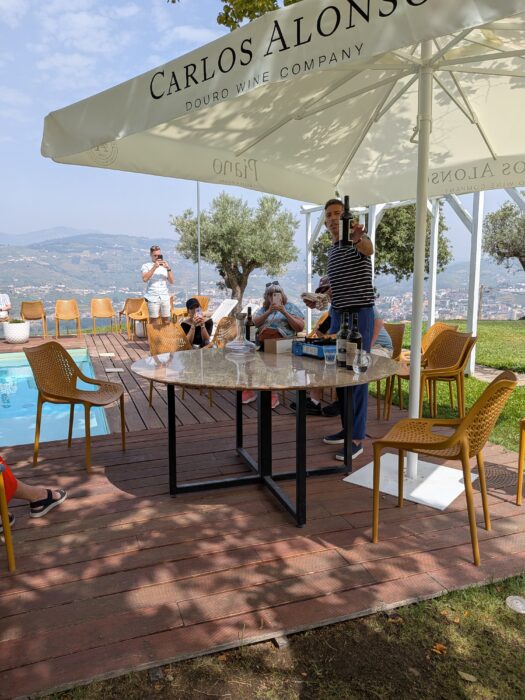
Port Tasting vs Douro Valley Wine Tour
I did both a Douro Valley day trip and port house tours in Porto. They are completely different experiences and both worth doing if you have time.
Douro Valley tour: Full-day experience visiting vineyards where grapes grow, seeing the terraced hillsides, learning about production at source, boat cruise on the river. You taste port but the focus is the valley itself – the landscape, the wine culture, the complete experience.
Porto port cellars: Focused specifically on port production and tasting. You are in the aging cellars where port matures for decades. More concentrated education about different port styles and how they are made. Shorter time commitment (1-2 hours per cellar).
What I recommend: Do the Douro Valley tour first. Understanding where the grapes grow and how port travels down the river in those rabelo boats makes the cellar tours more meaningful. After seeing the source, the aging cellars and production process make more sense.
I visited Porto Cruz and Quevedo after my Douro tour, and I could actually visualize where the grapes came from and appreciate the full journey from vineyard to cellar to glass.

Practical Port Tasting Tips
Book Cheese or Food Pairings: Port is very sweet. Drinking 4-5 ports without food is hard on your palate and your stomach. Cheese, chocolate, or charcuterie pairings make the experience much better. This is my biggest regret – I should have booked cheese with my Quevedo tasting.
Book Online in Advance: Prices are usually better online than walk-in rates. Plus you guarantee your spot and preferred time. Many cellars offer “reserve now, pay later” options.
Limit to 2 Cellars Maximum: After two tastings (8-10 different ports), your palate is saturated and you are feeling the alcohol. More is not better. Quality over quantity.
Go Early or Late: Mid-afternoon (2-4pm) is busiest with tour groups. Go before noon or after 4pm for fewer crowds.
Do Not Drive After: Port is 19-22% alcohol and you will taste multiple glasses. Walk, take public transport, or arrange rides. Do not drive.
Wear Layers: The cellars are cool (they need to be for proper wine storage). Even in August heat, bring a light jacket for the cellar tours.
Ask Questions: The guides are knowledgeable and usually happy to go deeper if you show interest. Ask about specific years, production differences, aging processes.
Warning
Do not visit port cellars if you are already drunk or hungover. Port is strong and sweet – it will make you feel worse, not better. Go when you are fresh and can actually appreciate the experience.

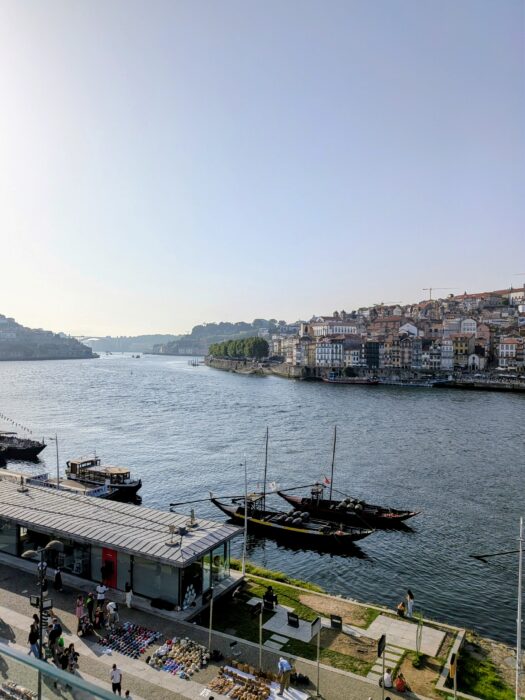
Combining Port Tasting with Other Activities
Vila Nova de Gaia is not just about port cellars. Once you are across the river, there are other things worth doing:
Riverside walk: The waterfront promenade along the Douro is beautiful. Walk along the river, past the port houses, toward Jardim do Morro for great Porto views.
Mercado Beira-Rio: Food market south of the port houses. I had incredible octopus here for 18 euros. Good vegetarian options too. Much better value than touristy Ribeira restaurants.
Jardim do Morro: Park and viewpoint at the Gaia end of the upper bridge. Popular sunset spot but can be crowded. You can get similar views from other spots along the waterfront.
Cable car (Teleférico de Gaia): Connects the waterfront to the upper level. Nice views but short ride (5 minutes). Only worth it if you hate walking uphill.
Plan for an afternoon: Port tasting plus lunch at Mercado Beira-Rio plus riverside walk makes a nice half-day in Gaia. Then cross back to Porto for dinner and evening plans.
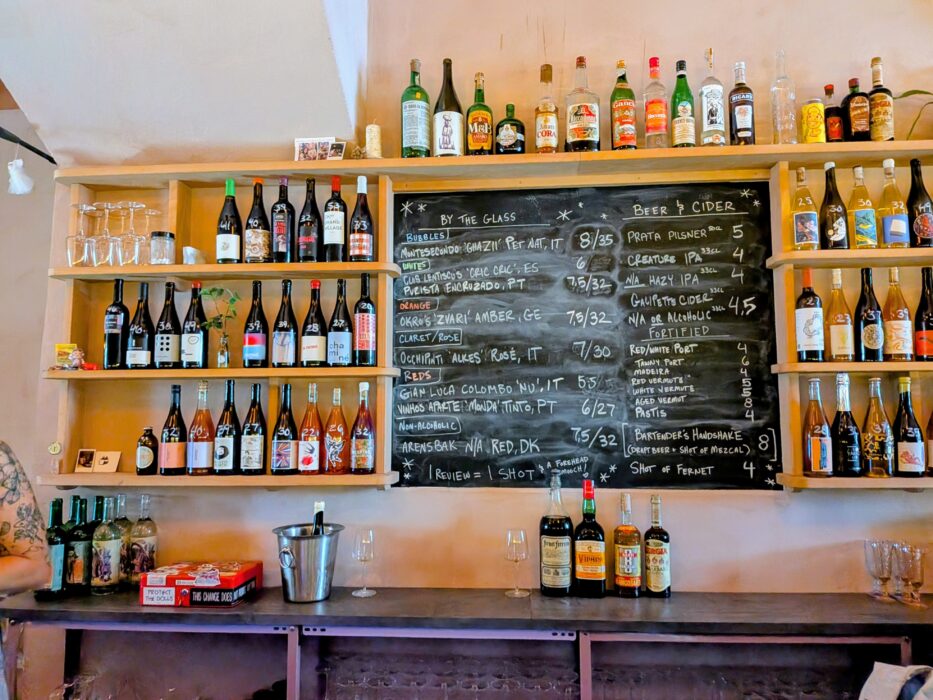
Port Tasting vs Wine Bars in Porto
After visiting port cellars, I also went to wine bars in Porto like Folios de Baco, Bonita, and Funq. These are completely different vibes.
Port cellars: Educational, structured, touristy. You learn about production and history. Good for understanding what port is and how it is made. But it feels like a tour/activity, not just drinking wine.
Wine bars: Casual, social, local atmosphere. You are there to drink good wine and relax, not to learn. Staff can still recommend ports and explain differences, but it is more relaxed. Better for evenings when you just want a glass of something good without the tour element.
What I recommend: Do one or two port cellar tours to learn the basics. Then visit wine bars to actually enjoy port in a social setting without the educational framework.
Budget Breakdown: Port Tasting Costs
What I actually spent on port experiences:
Porto Cruz rooftop (2 visits): 40 euros total (20 euros per visit for port and cocktails)
Quevedo 4-port tasting: 18 euros
Wine bars (various nights): 30 euros total (6-8 euros per glass across multiple bars)
If you want to experience port properly but keep costs down:
- Visit Porto Cruz rooftop (15-20 euros for views + unofficial tasting)
- One other cellar tour (15-20 euros)
- Skip third/fourth cellars – not worth the money or the palate fatigue
- Buy a bottle to take home if you find something you love (15-40 euros at cellar shops, often cheaper than Porto wine stores)
Budget option: Skip organized tours entirely. Many cellars have attached wine bars where you can just order port by the glass without doing the full tour. You miss the education but save money and time.
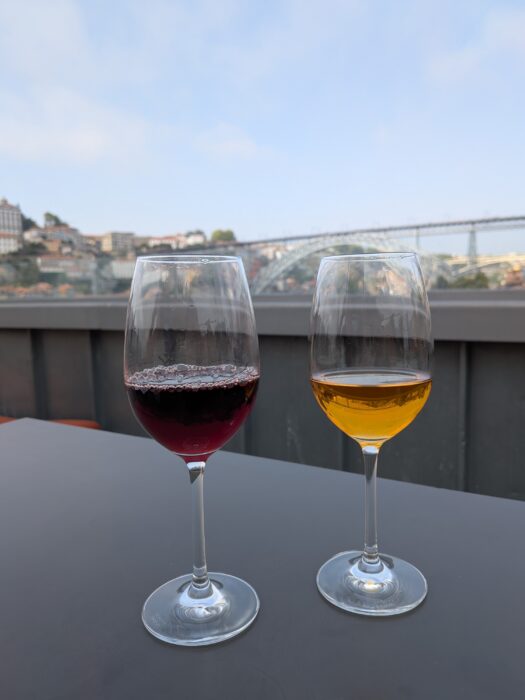
Can You Visit Port Houses Without Booking?
Yes, most cellars accept walk-ins, but booking ahead is better for several reasons:
Better prices: Online booking is usually 2-5 euros cheaper than walk-in rates.
Guaranteed spot: Popular cellars (Sandeman, Cálem, Graham’s) can fill up, especially in summer. Booking ensures you get in.
Preferred timing: Walk-ins take whatever tour time is available next. Booking lets you choose the time that fits your schedule.
Skip lines: Some cellars have separate entry for pre-booked visitors.
That said, if you are spontaneous and flexible with timing, walk-ins work fine. Just expect to potentially wait or pay slightly more.
Money Saver
Buy port bottles at the cellars if you love something specific. Cellar prices are often 20-30% cheaper than Porto wine shops for the same bottles. Even accounting for luggage space, it is worth it if you find a vintage or tawny you really love.

My Port Tasting Recommendations
If you have limited time in Porto and want the best port experience:
Minimum (2 hours total):
- Porto Cruz rooftop for views and casual tasting
- One proper cellar tour (Quevedo, Cálem, or Taylor’s) for education
- Done. You have seen cellars, tasted port, learned the basics.
If you have more time (half day):
- Two cellar tours with different styles (one traditional like Cálem, one with better views like Graham’s)
- Lunch at Mercado Beira-Rio
- Riverside walk
- Evening at a Porto wine bar to enjoy port socially without tour structure
Skip entirely if:
- You do not like sweet wine – port is sweet by definition
- You do not drink alcohol – tastings are the main point
- You have mobility issues and struggle with stairs – many cellars have steep stairs and uneven surfaces
Port tasting is a Porto signature experience and worth doing. Just do not overdo it. Two cellars maximum, book cheese pairings, and save room to actually enjoy port at wine bars without the educational structure.
Combine Port Tasting with River Cruises
- 6 Bridges Cruise with Port Wine – 20 euros
– 4.7/5 – 50-minute cruise, passes all 6 Porto bridges, includes port wine tasting on boat - Wine Tasting Boat Tour – 25 euros
– 4.8/5 – Combines river cruise with 4 port wine tastings, learn about Porto’s bridges and wine history - Standard 6 Bridges Cruise – 15 euros
– 4.6/5 – Classic 50-minute cruise without wine, best value basic option
Related Porto Guides
- Porto Travel Guide: 5 Weeks Living in Portugal
- 3 Days in Porto: Experience-Led Itinerary
- Douro Valley Day Trip from Porto
- Best Wine Bars in Porto
- Best Restaurants in Porto
- Where to Stay in Porto
- Porto on a Budget
Last Updated: November 2025

